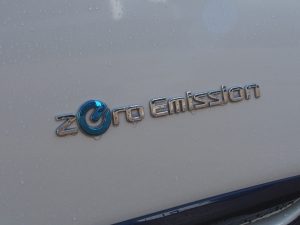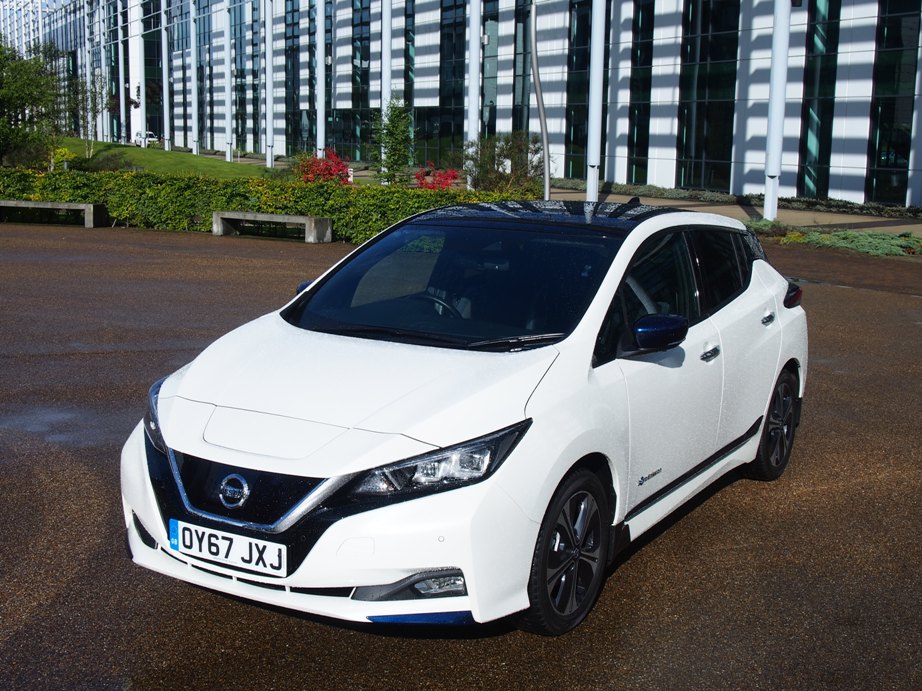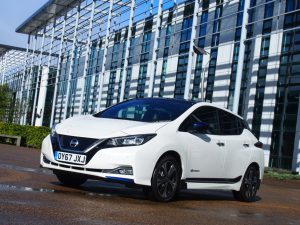… Nissan Leaf Tekna …
The annual Geneva Motor Show is on at the moment. What used to be an expectant and exciting celebration of the automobile as we knew it and loved it has become something more of a clinical and soul-less vision of mass public transportation options. Petrol and diesel models are about as proliferous as dinosaurs – the future is electric.
 Or so they would have you believe. Maybe not, petrol and dieselheads are a die-hard bunch, but it is primarily governments who are driving this change. They want to reduce emissions and the easiest target is all around us. Ignore the tons of stuff spewed out by aeroplanes or exhausted by ships and boats, and the burning of fossil fuels around the globe to make electricity and provide industrial power – let’s go for the easy option, the automobile.
Or so they would have you believe. Maybe not, petrol and dieselheads are a die-hard bunch, but it is primarily governments who are driving this change. They want to reduce emissions and the easiest target is all around us. Ignore the tons of stuff spewed out by aeroplanes or exhausted by ships and boats, and the burning of fossil fuels around the globe to make electricity and provide industrial power – let’s go for the easy option, the automobile.
For the moment, the car, van, bus and lorry driving folk are the prime target. Governments across Britain, Europe and parts of the rest of the world have put a time limit on petrol and diesel powered cars forcing the automotive industry to go electric – with little thought for how we get there.
A switch from oil based fuels is going to put a lot of jobs at risk unless they can convince the drillers and divers to become miners and diggers creating massive holes in the ground in remote parts of the world looking for exotic and expensive minerals and metals. As if that won’t have an effect on pollution!
Then there is the added problem of disposal of batteries after they are spent, that’ll be costly and risky as well. But before we get to that stage there is the provision of electricity itself and the necessary charging infrastructure. If you thought Post Office queues were a nightmare of the past, wait till you start looking for an available public electric car charger.
It just seems as though in the rush to get cleaner air, which is vital for our future, the politicians haven’t quite thought the consequences of their actions through. Before they ban something as essential as personal and commercial transport they need to have something workable, reliable and plentiful in place. At the moment, they haven’t. For instance, there is a railway station less than a hundred yards from my front door, but I rarely go by train. Why? The infrequency of the service, cleanliness of the rolling stock and the need to change trains to reach a specific destination, not to mention replacement bus services. One other thing, there is no service on Sundays!
 Which brings me to the Nissan Leaf. Just how practical are electric cars? The three biggest drawbacks are range, charging times and of course, cost. It has to be said that all three of these are being addressed and will improve and will improve rather more rapidly than Darwin’s evolution of species. In the meantime we have hybrid technology which is making great strides, but it too will no doubt become outlawed in due course providing yet another excuse for fleecing the motorist!
Which brings me to the Nissan Leaf. Just how practical are electric cars? The three biggest drawbacks are range, charging times and of course, cost. It has to be said that all three of these are being addressed and will improve and will improve rather more rapidly than Darwin’s evolution of species. In the meantime we have hybrid technology which is making great strides, but it too will no doubt become outlawed in due course providing yet another excuse for fleecing the motorist!
Every motor vehicle manufacturer is now working on electrical power units. Even fully electric HGVs are now cruising up and down motorways in the US and in Europe while medium sized HGVs are already being trialled in city centres around the globe. Change is happening. It’s happening now, and it’s getting faster, but with governments trying to ban petrol and diesel by the mid 2020s, will it happen fast enough?
 Perhaps the Nissan Leaf points the way. First introduced 9 years ago the Leaf is now the biggest selling electric car in Europe. And deservedly so. It’s a very good car. Period. Regardless of what lies under the bonnet and propels the wheels, this is a good car.
Perhaps the Nissan Leaf points the way. First introduced 9 years ago the Leaf is now the biggest selling electric car in Europe. And deservedly so. It’s a very good car. Period. Regardless of what lies under the bonnet and propels the wheels, this is a good car.
Outwardly, the only giveaway apart from the badging is the lack of a front ‘grille’ although it still retains the Nissan family face. It has four doors, room for 4/5 folk and a big boot to carry stuff.
Inside the car it’s very roomy and the dashboard and controls look very familiar, especially to those who drive automatics. Of course there’s no ‘Starter’ button, more of a switch really and all that is required is a push of the large knob on the console, a prod of the accelerator and forward motion is instantaneous. In silence. Eerie, but very pleasant.
After that, this is two-pedal motoring, but with a difference. Pressing a blue button on the console activates what Nissan calls the ‘e-Pedal’. This just about provides the car with single pedal operation and enables the driver to slow down and come to a halt just by gradually easing off the accelerator. The conventional brakes are still there, but might only be used for emergency stops.
 Another feature is Nissan’s ProPilot self-driving and self-parking system which is another way of gradually introducing today’s motorists to the idea of autonomous cars. The self-parking system is self explanatory and is in current use in most new cars these days, but the ProPilot system takes science a stage further. By engaging this on a Motorway it will cruise at the driver’s desired speed while maintaining a safe distance to the car in front and will also ‘steer’ the car in the desired lane without any input from the driver. Having said that, the driver must have hands on the wheel at all times. If you take them off, the system cuts out. So you can’t read the newspaper or catch up on your email while driving. That will come all too soon enough though, eh?
Another feature is Nissan’s ProPilot self-driving and self-parking system which is another way of gradually introducing today’s motorists to the idea of autonomous cars. The self-parking system is self explanatory and is in current use in most new cars these days, but the ProPilot system takes science a stage further. By engaging this on a Motorway it will cruise at the driver’s desired speed while maintaining a safe distance to the car in front and will also ‘steer’ the car in the desired lane without any input from the driver. Having said that, the driver must have hands on the wheel at all times. If you take them off, the system cuts out. So you can’t read the newspaper or catch up on your email while driving. That will come all too soon enough though, eh?
As you would expect with an electric motor, the Leaf is a spirited wee thing. It can achieve 0 to 60mph in 8 seconds and has a theoretical top speed of 90mph, but that will be at the expense of range. Using the new WLTP testing method, Nissan reckons the Leaf has a real-world range of 168 miles but the average driver would be best to stick to a more practical and achievable 150 miles till he/she gets used to the new order. However, it is entirely possible to get 200 miles without charging and maybe a little more, using the on-board re-charging facility and a lighter right foot!
 Which makes this the ideal commuting car and decent touring option for those not in too much of a hurry. Nissan has its own inbuilt, on board SatNav system which maps all the suitable public charging points around the country, but if you still suffer from ‘range anxiety’, guess what? There is a range of independent charger mapping ‘apps’ out there which you can download to your phone, just to be sure, to be sure.
Which makes this the ideal commuting car and decent touring option for those not in too much of a hurry. Nissan has its own inbuilt, on board SatNav system which maps all the suitable public charging points around the country, but if you still suffer from ‘range anxiety’, guess what? There is a range of independent charger mapping ‘apps’ out there which you can download to your phone, just to be sure, to be sure.
Which brings us to price. Including the Government Plug-In grant, the Nissan Leaf Tekna will cost around £28,390. This press appraisal car did have another 3 grandsworth of extras which raises the appeal and style with an attractive pearlescent, two-tone paint job and blue exterior highlights, mudguards and a cargo organiser in the boot.
The result is a desirable, comfortable and very practical motor car in its own right which just happens to be powered by something which is silent and isn’t smelly, although re-fuelling will take a little longer. It’s cars like this which will make the transition from the present to the future easier and perhaps even enjoyable. Politicians need to re-think their plans, the carrot would be a better option than a stick.
But you know what, I could be sorely tempted. I really liked it.